
The following is a slightly expanded version of my original 2010 review.
James Whale’s Frankenstein (1931) was only the second entry in the first wave of cinematic horror, but it’s also what can be called the first modern horror picture. By that I mean the film is unapologetic about its horror content. There is none of the reticence of Tod Browning’s Dracula (1931) here. Frankenstein is a film that sets out to deliver genuine shocks—and shock effects—in its tale of mad scientist Henry Frankenstein (Colin Clive) bringing to life a monster (Boris Karloff) pieced together out of body parts purloined “from the grave, from the gallows” and indeed anywhere.
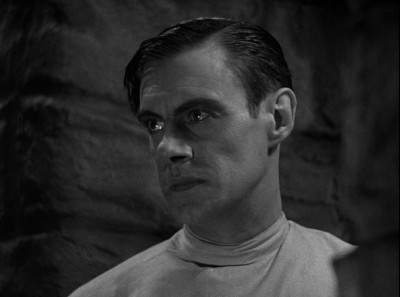
Ironically, James Whale took the project because his first two films—Journey’s End (1930) and Waterloo Bridge (1931)—had WWI backgrounds. Whale had been brought to Hollywood on the strength of his stage productions of Journey’s End (in the West End and on Broadway) and he feared that all this was going to get him typecast as nothing but a war specialist. Well, tackling Frankenstein solved that: Now he’s forever known for it and the three horror films he made in its wake. Sometimes you just can’t win, but most of us aren’t complaining because Whale’s quartet of horror pictures are among the wonders of film.
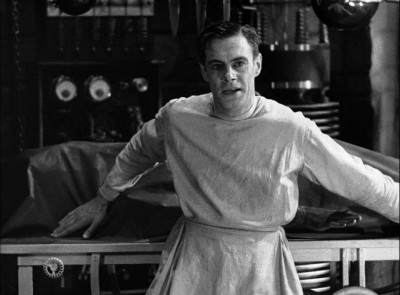
Whale’s first film showed little of his cinematic bravura. Waterloo Bridge, on the other hand, offered us something like the Whale we now know, but Frankenstein cemented the deal. Here Whale emerges in full flower—the stage director in love with the theatrical, and drunk on the possibilities of film. Those two things, theater and cinematic possibilities, color everything about the film. Everything is theatrical, including the film’s gothic landscape “exteriors” with their painted backdrops. The creation of the monster is a theatrical event—complete with an audience for the specific purpose of being an audience. Henry Frankenstein even remarks, “Quite a good scene, isn’t it? One man crazy—three very sane spectators!” And he’s right—it is a good scene.
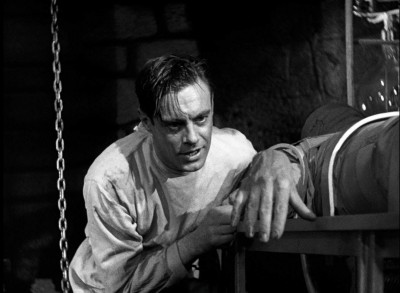
At the same time, Whale is on the loose cinematically, ignoring rules as he goes. He even opens one scene with three of his trademark gigantic closeups before he offers us the traditional establishing shot. The effect is still startling. The creation scene may be theater, but the technique—there are more than 70 cuts in the sequence—is pure film. His film is filled with shaved sets so that his camera can literally pass through walls—walls which, it should be noted, are almost always decorated with things that would hardly be found inside a solid wall. It doesn’t matter to Whale—what he wants is the effect. And he gets it. He aims for spectacle and achieves it.
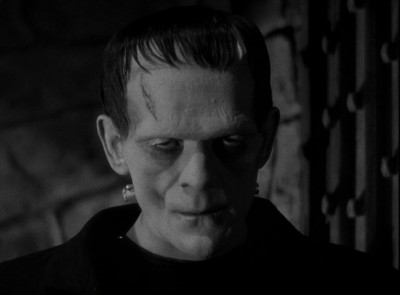
He’s also a master showman—note how long he keeps us from getting a look at the monster. The creature’s face is bandaged when he’s on the operating table. He’s kept offscreen afterwards for a cutaway to Henry’s perturbed father (Frederick Kerr). Then when the film does return to Frankenstein’s watchtower laboratory, there’s a fairly long dialogue between Henry and Dr. Waldman (Edward Van Sloan) about the creature (“You have created a monster and it will destroy you”). When the monster does finally show up, with the film nearly half over, the lights are lowered and then he backs into the room, slowly turning to face us—whereupon Whale pays off with three ever-closer shock closeups. Today, we know what the monster looks like. Imagine the effect in 1931.
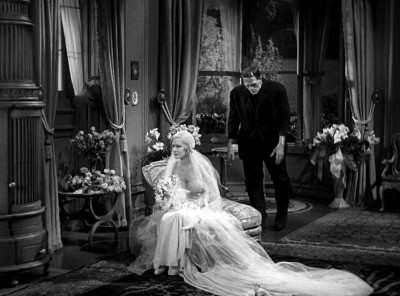
There is so much to this film that it would be possible to go into it scene by scene—in some cases, shot by shot. However, if you like your subtext—and Whale is full of (possibly inadvertent) subtext—consider the monster in terms of Whale’s homosexuality. Consider the monster—the reason Henry has put off his wedding and gone to live in this phallic tower—as the embodiment of that sexuality, and as something that is quickly shoved into a dungeon (closet) the minute it’s inconvenient. Consider the price Henry pays for trying to ignore the monster and his responsibility. You can take these concepts through the entire film and on into Whale’s other work. (Trust me, I’ve done it in publications that allowed for the requisite length.) But if that bothers you—and it does bother some people—you can just sit back and watch the original James Whale horror show about “The man who made a monster,” and also made a star out of Boris Karloff.
The Thursday Horror Picture Show will screen Frankenstein Thursday, Nov. 14, at 8 p.m. in the Cinema Lounge at The Carolina Asheville and will be hosted by Xpress movie critics Ken Hanke and Justin Souther.




I assume the remastered version is the Universal 75 year edition?
No, the 2012 Blu-ray. Yes, they sold these movies to me again — primarily so I could get The Invisible Man with the right music coming from Dr. Kemp’s radio. However, I was startled by how much cleaner and sharper most of these looked — and they all sounded better. Anyway, I had a gift certificate and they were on sale and I ended up paying about sixteen bucks for the set.
Of Jeez this is embarrassing. I looked at my collection database and I realized I don’t have Frankenstein, Bride of Frankenstein or The Invisible Man on DVD. Just on VHS for the 12V player and 15″ screen at our cabin. How’d I miss that? Probably because that’s where my wife and I hunker down to watch our B&W horror/scifi classics. Time for a trip to Amazon.
In my defense I can say I do have Re-Animator, Angel Heart, Night/Curse of the Demon and Jacob’s Ladder on DVD.
But cripes, how the hell did I miss that? (Kicking sounds).
If you hang on and keep an eye on it, they’ll knock the price of the Blu-ray set down to $60-ish on occasion.